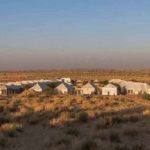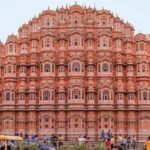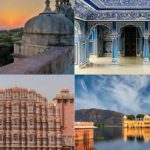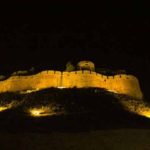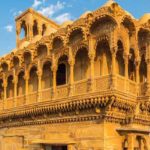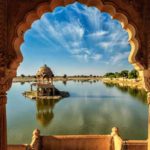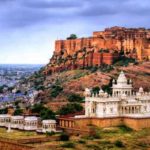Top 8 Places to Visit in Jaisalmer is the western part of Rajasthan. It is popularly known as a Golden city due to the surrounding Thar Desert, oldest forts, temples etc. Jaisalmer is a one-of-a-kind destination with forts, temples, lakes, and deserts, among other things. Explore the Thar Desert’s vast stretches, marvel at the elegant palaces and forts, and spend the evening on the sand dunes under a star-filled sky; All of these and more are included in the top things to do in Jaisalmer for an unforgettable experience. The charming town of Rajasthan, dubbed the “Golden City,” never fails to pique the interest of tourists looking for something different to do.
Jaisalmer is a tourist haven with a plethora of tourist attractions. Beautiful forts, ancient temples, picturesque lakes, and lively bazaars attract visitors to this golden capital. The magnificent Jaisalmer Fort is the most well-known of all the Jaisalmer tourist attractions. The fort houses about a quarter of the city’s population, making it a lively place to visit at any time of day.
Even inside the fort’s walls, you’ll be shocked to discover a multitude of well-known tourist attractions in Jaisalmer. The fort is surrounded by bazaars such as Manak Chowk, Pansari Bazaar, and Bhatia Bazaar. If you venture a little farther from the fort, you can come across some enchanting lakes, such as Gadsisar Lake, where you can take scenic boat rides or visit preserved sites Salim Singh Ki Haveli and Patwon Ki Haveli are two historic residences worth visiting for their architectural beauty.
Visit the ruins of the Kuldhara village, which the locals say is haunted, just outside the city for a glimpse into ancient history You can visit a beautiful graveyard from an abandoned village, which houses handcrafted fully designed sandstone chhatris to please the architecture lover in you Top 8 Places to Visit in Jaisalmer.
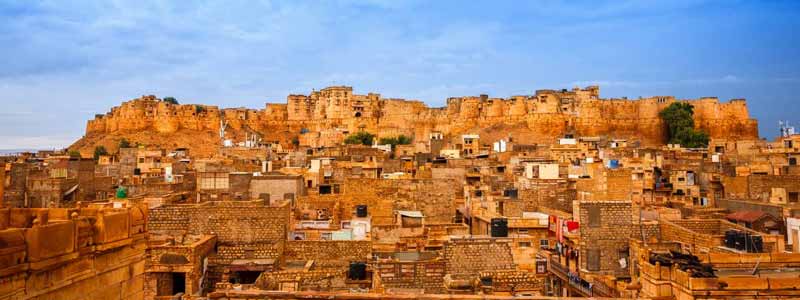
Jaisalmer Fort
The fort of Jaisalmer is a sight to behold and one that should be remembered. UNESCO has listed it as a world heritage site. It is located in the Rajasthani city of Jaisalmer (India). After Chittorgarh, it is the second oldest of Rajasthan’s major forts. Rawal Jaiswal, a Rajput king, constructed it in 1156 AD. The fort is located in the centre of the vast Thar desert’s sand dunes on Trikuta hill, Many fights have taken place there.
Its large yellow sandstone walls are a tawny lion colour throughout the day, then fade to honey gold as the sun sets, blending the fort into the yellow desert. As a result, it’s also known as Sonar Quila (Golden Fort). The fort is 1500 feet long and 750 feet high, and it is situated on a hill that rises 250 feet above the surrounding countryside side and about 5000 people still resides in its imposing walls.
According to legend, Maharaja chose the place after consulting a wise hermit. The mystic informs the Jaiswal that the Hindu deity Lord Krishna has praised the place, and that a fort constructed there will be nearly imperceptible to the king’s enemies. Visitors can see only a sheer golden cliff from 30 miles away. As his capital, he constructed this fort, Since the previous fort Lodurva was too vulnerable to invasions, it was replaced.
Every part of the Jaisalmer fort is made of soft yellow Jurassic sandstone, from the outer walls to the palace, temples, and houses inside. The fort is 250 feet tall and offers views of almost the entire area. It has 99 bastions, 92 of which were constructed to serve as gun platforms between 1633 and 1647. Ganesh Pol, Suraj Pol, Bhoot Pol, and Hawa Pol are four big getaways. There was a death well, which the second gate threw traitors and criminals through. The fourth gateway leads to the main chowk, where several acts of Johar (self-immolation) have occurred, Top 8 Places to Visit in Jaisalmer.
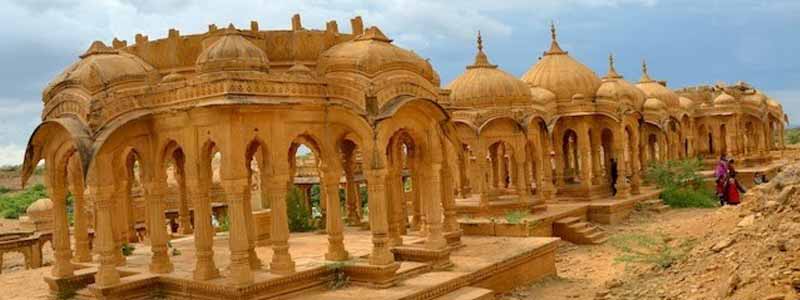
Bada Bagh
BadaBagh translates to “Huge Garden.” It was founded during the reign of Maharawal Jait Singh in the early 16th century. After his father died, his son Lunakaran finished the building. That’s right, it was developed over two centuries and is still going strong.
The nobles and their families were cremated in the courtyard, which acted as a memorial. The garden is located in a secluded location, giving it an eerie calmness. The feeling of serenity makes you feel good, and all of the sweat, ride, and hustle you went through to get to Jaisalmer seems worth it, completely worth it.
We recommend visiting this location at sunrise or sunset to get some great pictures. Every visitor to Jaisalmer has visited BadaBagh and admired its beauty in front of their peers. That’s exactly what you’ll be doing once you arrive.
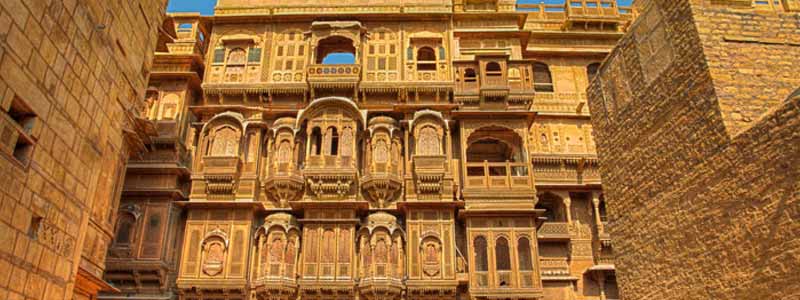
Patwon Ki Haveli
The Patwon Ji ki Haveli is a fascinating piece of architecture and one of Jaisalmer’s most significant havelis. This is due to two factors: first, it was the first haveli built in Jaisalmer, and second, it is a cluster of five small havelis rather than a single haveli. The first of these havelis was commissioned and designed by Guman Chand Patwa in the year 1805 and is the largest and most ostentatious of them all.
Patwa is thought to have been a wealthy man and a well-known trader in his day. He was able to afford it, so he had separate stories built for each of his five sons. These were done over a 50-year period. The first 60 years of the nineteenth century saw the construction of all five buildings.
The’mansion of brocade merchants’ is another name for the havelis. This name was given to the family because they dealt in gold and silver threads for embroidering dresses. However, there are theories that suggest these traders made a lot of money by opium smuggling and money lending.
This is Jaisalmer‘s largest Haveli, which is situated on a narrow street. The government currently occupies this haveli and uses it for a variety of purposes. The Archeological Survey of India’s office and the State Art and Craft Department are both located within the haveli.
Despite these encroachments and abuses, there are still a large number of paintings and mirrors on the walls. Its gateways and arches are also noteworthy features. On each arch, you’ll find unique depictions and themes. Despite the fact that the entire structure is made of yellow sandstone, the Patwon Ji ki Haveli’s main gateway is brown in colour.
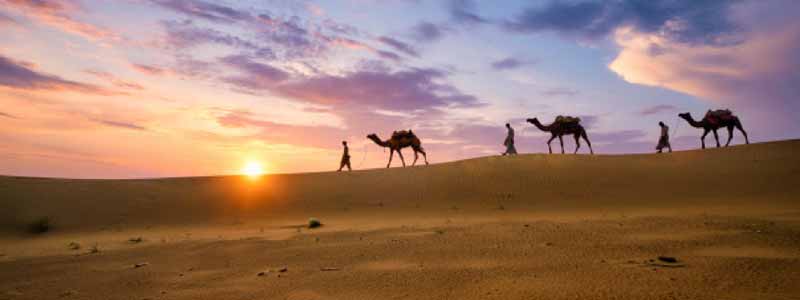
Sam Sand Dunes
Sam sand dunes are one of the most authentic desert dune sites in India, with 30-60 metre tall sand dunes and many tourists enjoying camel or jeep safaris. Sam is 45 km west of Jaisalmer city, and you can reach it by hiring a car from Jaisalmer and then staying in one of the many desert camps constructed within a 2-3 km radius of the sand dunes.
The best time to visit Sam sand dunes is in the evening (sunset) between 4 and 7 p.m., or early in the morning, between 4 and 6 a.m. To get to the sunset spot, which is 20-30 minutes from the campsite, you can hire a camel or a jeep (both of which are available at desert camps).
The best months to visit Sam or even Jaisalmer are October to February (February), as these are the renaming months, All of the camps are closed, and there will be only a few camel riders available. You won’t be able to attend the evening musical programme at Sam (at the desert camps) during the summer and monsoon months, as many travellers enjoy it, Top 8 Places to Visit in Jaisalmer.
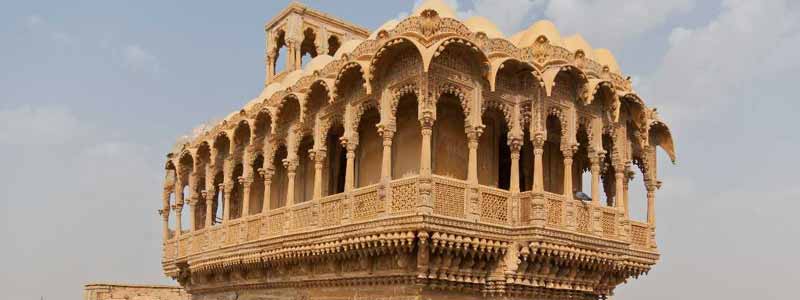
Salim Singh Ki Haveli
The Salim Singh Ki Haveli, named after its owner, Salim Singh Mohta, was built about 300 years ago in 1815. This haveli was constructed from the ruins of an older haveli that stood near the Jaisalmer Fort in the 17th century. The Haveli was occupied by the Mehta family of Jaisalmer after a period of construction, which was said to be the most powerful family in the world at the time.
This haveli is best known for its one-of-a-kind architectural style, which features a peacock-shaped roof complemented by an elegant pavilion. To make the original haveli more spacious, grand, and taller, Salim Singh added two additional floors of wood. Jaisalmer Tuskers guard the Haveli’s entrances, which are made of sand and stone and have a lifelike look.
Its structure has 38 balconies, each with its own unique design and walls covered in Mughal imperial paintings. Since the front facet of the haveli resembles the stern of a ship, it is also known as Jahazmahal. There is also a ‘Moti Mahal’ inside the haveli. This was the location where the proprietors used to enjoy royal dances. Established in 1815, this architecturally important residence features a peacock-shaped roof and numerous balconies.
Salim Singh ki Haveli is one of Jaisalmer’s most well-known attractions, and it has long been regarded as a must-see destination. It is situated in the heart of the city of Jaisalmer, in the vicinity of the Jaisalmer railway station The city of Jaisalmer’s numerous stately homes and havelis represent the fact that it is an integral part of Rajasthan’s rich history. The Haveli, one of the most ambitious constructions of its period, is so magnificent that it even inspired envy among the rulers.
Desert National Park
Desert National Park of Jaisalmer is a wildlife sanctuary in Rajasthan’s state of Rajasthan, near the town of Jaisalmer. The Desert National Park, located in the sand dunes of the Thar Desert, is one of India’s largest national parks and one of the top places to visit on a Jaisalmer tour.
In 1980, the Desert National Park was created, It also portrays the Thar Desert’s ecosystem. The park, which occupies an area of 3162 square kilometres, is mostly surrounded by sand dunes. Compact salt lake bottoms, fixed dunes, and craggy rocks make up the park’s main area. Rajbaugh Lake, Milak Lake, and Padam Talao Lake are among the many lakes found within the national park.
Chinkara, desert fox, Bengal fox, desert cat, blackbuck, hedgehog, and other animals frequently seen in the park include the chinkara, desert fox, Bengal fox, desert cat, blackbuck, hedgehog, and others. Russell viper, saw scaled viper, monitor lizard, krait, and other reptiles call this place home. The park is home to over 40 reptile species. Thorny shrubs, cacti, grasses, and a few other plants and trees make up the fauna. The Desert National Park has a series of 180 million-year-old animal and plant fossils. In the city, some 6 million-year-old dinosaur fossils have been discovered.
Gadisar Lake
Add New Post
(opens in a new tab)Preview(opens in a new tab)Add titleTop 8 Places to Visit in Jaisalmer
Top 8 Places to Visit in Jaisalmer is the western part of Rajasthan. It is popularly known as a Golden city due to the surrounding Thar Desert, oldest forts, temples etc. Jaisalmer is a one-of-a-kind destination with forts, temples, lakes, and deserts, among other things. Explore the Thar Desert’s vast stretches, marvel at the elegant palaces and forts, and spend the evening on the sand dunes under a star-filled sky; All of these and more are included in the top things to do in Jaisalmer for an unforgettable experience. The charming town of Rajasthan, dubbed the “Golden City,” never fails to pique the interest of tourists looking for something different to do.
Jaisalmer is a tourist haven with a plethora of tourist attractions. Beautiful forts, ancient temples, picturesque lakes, and lively bazaars attract visitors to this golden capital. The magnificent Jaisalmer Fort is the most well-known of all the Jaisalmer tourist attractions. The fort houses about a quarter of the city’s population, making it a lively place to visit at any time of day, Top 8 Places to Visit in Jaisalmer.
Even inside the fort’s walls, you’ll be shocked to discover a multitude of well-known tourist attractions in Jaisalmer. The fort is surrounded by bazaars such as Manak Chowk, Pansari Bazaar, and Bhatia Bazaar. If you venture a little farther from the fort, you can come across some enchanting lakes, such as Gadsisar Lake, where you can take scenic boat rides or visit preserved sites Salim Singh Ki Haveli and Patwon Ki Haveli are two historic residences worth visiting for their architectural beauty.
Visit the ruins of the Kuldhara village, which the locals say is haunted, just outside the city for a glimpse into ancient history You can visit a beautiful graveyard from an abandoned village, which houses handcrafted fully designed sandstone chhatris to please the architecture lover in you Top 8 Places to Visit in Jaisalmer.

Jaisalmer Fort
The fort of Jaisalmer is a sight to behold and one that should be remembered. UNESCO has listed it as a world heritage site. It is located in the Rajasthani city of Jaisalmer (India). After Chittorgarh, it is the second oldest of Rajasthan’s major forts. Rawal Jaiswal, a Rajput king, constructed it in 1156 AD. The fort is located in the centre of the vast Thar desert’s sand dunes on Trikuta hill, Many fights have taken place there.
Its large yellow sandstone walls are a tawny lion colour throughout the day, then fade to honey gold as the sun sets, blending the fort into the yellow desert. As a result, it’s also known as Sonar Quila (Golden Fort). The fort is 1500 feet long and 750 feet high, and it is situated on a hill that rises 250 feet above the surrounding countryside side and about 5000 people still resides in its imposing walls.
According to legend, Maharaja chose the place after consulting a wise hermit. The mystic informs the Jaiswal that the Hindu deity Lord Krishna has praised the place, and that a fort constructed there will be nearly imperceptible to the king’s enemies. Visitors can see only a sheer golden cliff from 30 miles away. As his capital, he constructed this fort, Since the previous fort Lodurva was too vulnerable to invasions, it was replaced.
Every part of the Jaisalmer fort is made of soft yellow Jurassic sandstone, from the outer walls to the palace, temples, and houses inside. The fort is 250 feet tall and offers views of almost the entire area. It has 99 bastions, 92 of which were constructed to serve as gun platforms between 1633 and 1647. Ganesh Pol, Suraj Pol, Bhoot Pol, and Hawa Pol are four big getaways. There was a death well, which the second gate threw traitors and criminals through. The fourth gateway leads to the main chowk, where several acts of Johar (self-immolation) have occurred, Top 8 Places to Visit in Jaisalmer.

Bada Bagh
BadaBagh translates to “Huge Garden.” It was founded during the reign of Maharawal Jait Singh in the early 16th century. After his father died, his son Lunakaran finished the building. That’s right, it was developed over two centuries and is still going strong.
The nobles and their families were cremated in the courtyard, which acted as a memorial. The garden is located in a secluded location, giving it an eerie calmness. The feeling of serenity makes you feel good, and all of the sweat, ride, and hustle you went through to get to Jaisalmer seems worth it, completely worth it.
We recommend visiting this location at sunrise or sunset to get some great pictures. Every visitor to Jaisalmer has visited BadaBagh and admired its beauty in front of their peers. That’s exactly what you’ll be doing once you arrive.

Patwon Ki Haveli
The Patwon Ji ki Haveli is a fascinating piece of architecture and one of Jaisalmer’s most significant havelis. This is due to two factors: first, it was the first haveli built in Jaisalmer, and second, it is a cluster of five small havelis rather than a single haveli. The first of these havelis was commissioned and designed by Guman Chand Patwa in the year 1805 and is the largest and most ostentatious of them all.
Patwa is thought to have been a wealthy man and a well-known trader in his day. He was able to afford it, so he had separate stories built for each of his five sons. These were done over a 50-year period. The first 60 years of the nineteenth century saw the construction of all five buildings.
The’mansion of brocade merchants’ is another name for the havelis. This name was given to the family because they dealt in gold and silver threads for embroidering dresses. However, there are theories that suggest these traders made a lot of money by opium smuggling and money lending.
This is Jaisalmer‘s largest Haveli, which is situated on a narrow street. The government currently occupies this haveli and uses it for a variety of purposes. The Archeological Survey of India’s office and the State Art and Craft Department are both located within the haveli.
Despite these encroachments and abuses, there are still a large number of paintings and mirrors on the walls. Its gateways and arches are also noteworthy features. On each arch, you’ll find unique depictions and themes. Despite the fact that the entire structure is made of yellow sandstone, the Patwon Ji ki Haveli’s main gateway is brown in colour.

Sam Sand Dunes
Sam sand dunes are one of the most authentic desert dune sites in India, with 30-60 metre tall sand dunes and many tourists enjoying camel or jeep safaris. Sam is 45 km west of Jaisalmer city, and you can reach it by hiring a car from Jaisalmer and then staying in one of the many desert camps constructed within a 2-3 km radius of the sand dunes.
The best time to visit Sam sand dunes is in the evening (sunset) between 4 and 7 p.m., or early in the morning, between 4 and 6 a.m. To get to the sunset spot, which is 20-30 minutes from the campsite, you can hire a camel or a jeep (both of which are available at desert camps).
The best months to visit Sam or even Jaisalmer are October to February (February), as these are the renaming months, All of the camps are closed, and there will be only a few camel riders available. You won’t be able to attend the evening musical programme at Sam (at the desert camps) during the summer and monsoon months, as many travellers enjoy it, Top 8 Places to Visit in Jaisalmer.

Salim Singh Ki Haveli
The Salim Singh Ki Haveli, named after its owner, Salim Singh Mohta, was built about 300 years ago in 1815. This haveli was constructed from the ruins of an older haveli that stood near the Jaisalmer Fort in the 17th century. The Haveli was occupied by the Mehta family of Jaisalmer after a period of construction, which was said to be the most powerful family in the world at the time.
This haveli is best known for its one-of-a-kind architectural style, which features a peacock-shaped roof complemented by an elegant pavilion. To make the original haveli more spacious, grand, and taller, Salim Singh added two additional floors of wood. Jaisalmer Tuskers guard the Haveli’s entrances, which are made of sand and stone and have a lifelike look.
Its structure has 38 balconies, each with its own unique design and walls covered in Mughal imperial paintings. Since the front facet of the haveli resembles the stern of a ship, it is also known as Jahazmahal. There is also a ‘Moti Mahal’ inside the haveli. This was the location where the proprietors used to enjoy royal dances. Established in 1815, this architecturally important residence features a peacock-shaped roof and numerous balconies.
Salim Singh ki Haveli is one of Jaisalmer’s most well-known attractions, and it has long been regarded as a must-see destination. It is situated in the heart of the city of Jaisalmer, in the vicinity of the Jaisalmer railway station The city of Jaisalmer’s numerous stately homes and havelis represent the fact that it is an integral part of Rajasthan’s rich history. The Haveli, one of the most ambitious constructions of its period, is so magnificent that it even inspired envy among the rulers.
Desert National Park
Desert National Park of Jaisalmer is a wildlife sanctuary in Rajasthan’s state of Rajasthan, near the town of Jaisalmer. The Desert National Park, located in the sand dunes of the Thar Desert, is one of India’s largest national parks and one of the top places to visit on a Jaisalmer tour.
In 1980, the Desert National Park was created, It also portrays the Thar Desert’s ecosystem. The park, which occupies an area of 3162 square kilometres, is mostly surrounded by sand dunes. Compact salt lake bottoms, fixed dunes, and craggy rocks make up the park’s main area. Rajbaugh Lake, Milak Lake, and Padam Talao Lake are among the many lakes found within the national park.
Chinkara, desert fox, Bengal fox, desert cat, blackbuck, hedgehog, and other animals frequently seen in the park include the chinkara, desert fox, Bengal fox, desert cat, blackbuck, hedgehog, and others. Russell viper, saw scaled viper, monitor lizard, krait, and other reptiles call this place home. The park is home to over 40 reptile species. Thorny shrubs, cacti, grasses, and a few other plants and trees make up the fauna. The Desert National Park has a series of 180 million-year-old animal and plant fossils. In the city, some 6 million-year-old dinosaur fossils have been discovered.
Gadisar Lake
Gadisar Lake is a man-made lake that was founded in 1400 AD by Raja Rawal Jaisal, the first king of Jaisalmer. It was later redesigned during Maharwal Gadsi Singh’s reign. The lake was built to store water that would later be used to supply the entire town of Jaisalmer. During those times, water was a scarce resource in this region As a result, this lake was known as sacred. Several shrines dating from that time period can be found along the lake’s banks. Though the original concept of providing lake water to the town no longer holds true, the lake still absorbs sufficient rain water throughout the year.
The lake is also home to a variety of birds. Several pigeons, ducks, and other birds can be seen during a visit to Gadisar Lake. Apart from enjoying the lake, you can also take a walk along the lake’s banks and spend as much time as you like admiring the lake’s beauty from all angles! You can also take a boat trip on the lake to see some of the smaller island structures that have developed within it, Top 8 Places to Visit in Jaisalmer.
Several gateways to the lake are made of the golden sandstones that are abundant in this region. ‘Tilon Ki Pol,’ which means Gate of Tilon, was built by a courtesan called ‘Tilon.’ Against the king’s wishes, Tilon dedicated this structure to Lord Satyanarayan by erecting a statue of Lord Vishnu. Despite numerous attempts to demolish the temple, it still stands!
Vyas Chhatri
The Vyas Chhatri, one of the most grand of all memorials, features exquisitely designed cenotaphs, making it a wonderful tourist attraction.
This memorial plaque in Jaisalmer is dedicated to Sage Vyas, the author of the Mahabharata epic, and serves as a formal cremation ground for Brahmins.
The Sage’s cenotaph is located to the north of the entire building. These cenotaphs were built as a mark of reverence for the royal family’s clans after their deaths.
The cenotaphs are made of yellow sandstone, and the pillars are topped with intricately built chhatris.
The opulence and grandeur of the chhatris and pillars attest to Rajasthani architecture’s timeless appeal. The best architects would be forced to consider how these buildings were constructed.
The fine detailing, figures, and materials used had to be of the highest quality. The Chhatri is also known as the sun-set stage, as it offers a single-shot view of Jaisalmer’s beautiful city. Vyas Chhatri is one of the city’s most prominent tourist attractions and landmarks, and is housed in the Bada Bagh structure.
The intricate carvings of dome-shaped pavilions are mesmerising in their presence when it comes to the structure. A visit here will leave you feeling peaceful and calm for the rest of your life, particularly during sunsets.
Gadisar Lake is a man-made lake that was founded in 1400 AD by Raja Rawal Jaisal, the first king of Jaisalmer. It was later redesigned during Maharwal Gadsi Singh’s reign. The lake was built to store water that would later be used to supply the entire town of Jaisalmer. During those times, water was a scarce resource in this region As a result, this lake was known as sacred. Several shrines dating from that time period can be found along the lake’s banks. Though the original concept of providing lake water to the town no longer holds true, the lake still absorbs sufficient rain water throughout the year.
The lake is also home to a variety of birds. Several pigeons, ducks, and other birds can be seen during a visit to Gadisar Lake. Apart from enjoying the lake, you can also take a walk along the lake’s banks and spend as much time as you like admiring the lake’s beauty from all angles! You can also take a boat trip on the lake to see some of the smaller island structures that have developed within it, Top 8 Places to Visit in Jaisalmer.
Several gateways to the lake are made of the golden sandstones that are abundant in this region. ‘Tilon Ki Pol,’ which means Gate of Tilon, was built by a courtesan called ‘Tilon.’ Against the king’s wishes, Tilon dedicated this structure to Lord Satyanarayan by erecting a statue of Lord Vishnu. Despite numerous attempts to demolish the temple, it still stands!
Vyas Chhatri
The Vyas Chhatri, one of the most grand of all memorials, features exquisitely designed cenotaphs, making it a wonderful tourist attraction.
This memorial plaque in Jaisalmer is dedicated to Sage Vyas, the author of the Mahabharata epic, and serves as a formal cremation ground for Brahmins.
The Sage’s cenotaph is located to the north of the entire building. These cenotaphs were built as a mark of reverence for the royal family’s clans after their deaths.
The cenotaphs are made of yellow sandstone, and the pillars are topped with intricately built chhatris.
The opulence and grandeur of the chhatris and pillars attest to Rajasthani architecture’s timeless appeal. The best architects would be forced to consider how these buildings were constructed.
The fine detailing, figures, and materials used had to be of the highest quality. The Chhatri is also known as the sun-set stage, as it offers a single-shot view of Jaisalmer’s beautiful city. Vyas Chhatri is one of the city’s most prominent tourist attractions and landmarks, and is housed in the Bada Bagh structure.
The intricate carvings of dome-shaped pavilions are mesmerising in their presence when it comes to the structure. A visit here will leave you feeling peaceful and calm for the rest of your life, particularly during sunsets.

